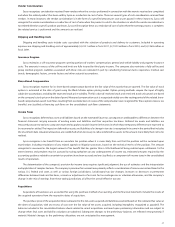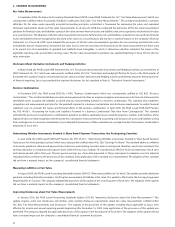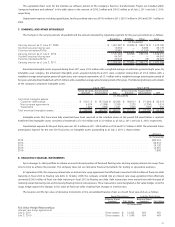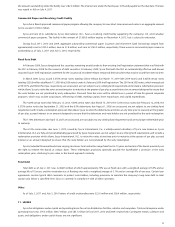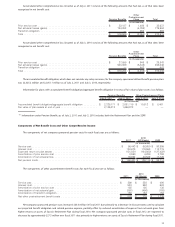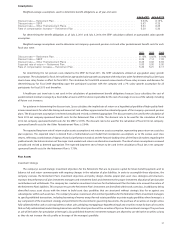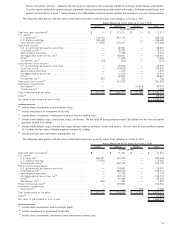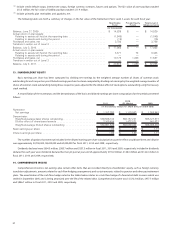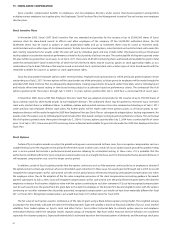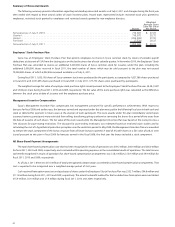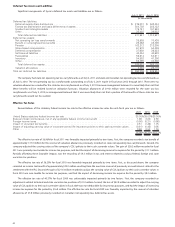Sysco 2011 Annual Report Download - page 81
Download and view the complete annual report
Please find page 81 of the 2011 Sysco annual report below. You can navigate through the pages in the report by either clicking on the pages listed below, or by using the keyword search tool below to find specific information within the annual report.
Assumptions
Weighted-average assumptions used to determine benefit obligations as of year-end were:
July 2, 2011 July 3, 2010
Discount rate — Retirement Plan..................................................... 5.94% 6.15%
Discount rate — SERP ............................................................ 5.93 6.35
Discount rate — Other Postretirement Plans. . ........................................... 5.94 6.32
Rate of compensation increase — Retirement Plan ........................................ 5.30 5.30
For determining the benefit obligations as of July 2, 2011 and July 3, 2010, the SERP calculations utilized an age-graded salary growth
assumption.
Weighted-average assumptions used to determine net company-sponsored pension costs and other postretirement benefit costs for each
fiscal year were:
2011 2010 2009
Discount rate — Retirement Plan . . .................................................... 6.15% 8.02% 6.94%
Discount rate — SERP ............................................................. 6.35 7.14 7.03
Discount rate — Other Postretirement Plans .............................................. 6.32 8.02 6.94
Expected rate of return — Retirement Plan ............................................... 8.00 8.00 8.00
Rate of compensation increase — Retirement Plan. ......................................... 5.30 5.21 6.17
For determining the net pension costs related to the SERP for fiscal 2011, the SERP calculations utilized an age-graded salary growth
assumption. The calculation for fiscal 2010 utilized an age-graded salary growth assumption with reductions taken for determining fiscal 2010 pay
due to base salary freezes in effect for fiscal 2010. The calculation for fiscal 2009 assumed various levels of base salary increase and decrease for
determining pay for fiscal 2009 depending upon the participant’s position with the company and a 7% salary growth assumption for all
participants for fiscal 2010 and thereafter.
A healthcare cost trend rate is not used in the calculations of postretirement benefit obligations because Sysco subsidizes the cost of
postretirement medical coverage by a fixed dollar amount, with the retiree responsible for the cost of coverage in excess of the subsidy, including
all future cost increases.
For guidance in determining the discount rate, Sysco calculates the implied rate of return on a hypothetical portfolio of high-quality fixed-
income investments for which the timing and amount of cash outflows approximates the estimated payouts of the company-sponsored pension
plans. The discount rate assumption is reviewed annually and revised as deemed appropriate. The discount rate to be used for the calculation of
fiscal 2012 net company-sponsored benefit costs for the Retirement Plan is 5.94%. The discount rate to be used for the calculation of fiscal
2012 net company-sponsored benefit costs for the SERP is 5.93%. The discount rate to be used for the calculation of fiscal 2012 net company-
sponsored benefit costs for the Other Postretirement Plans is 5.94%.
The expected long-term rate of return on plan assets assumption is net return on assets assumption, representing gross return on assets less
plan expenses. The expected return is derived from a mathematical asset model that incorporates assumptions as to the various asset class
returns, reflecting a combination of rigorous historical performance analysis and the forward-looking views of the financial markets regarding the
yield on bonds, the historical returns of the major stock markets and returns on alternative investments. The rate of return assumption is reviewed
annually and revised as deemed appropriate. The expected long-term rate of return to be used in the calculation of fiscal 2012 net company-
sponsored benefit costs for the Retirement Plan is 7.75%.
Plan Assets
Investment Strategy
The company’s overall strategic investment objectives for the Retirement Plan are to preserve capital for future benefit payments and to
balance risk and return commensurate with ongoing changes in the valuation of plan liabilities. In order to accomplish these objectives, the
company oversees the Retirement Plan’s investment objectives and policy design, decides proper plan asset class strategies and structures,
monitors the performance of plan investment managers and investment funds and determines the proper investment allocation of pension plan
contributions and withdrawals. The company has created an investment structure for the Retirement Plan that takes into account the nature of
the Retirement Plan’s liabilities. This structure ensures the Retirement Plan’s investment are diversified within each asset class, in addition to being
diversified across asset classes with the intent to build asset class portfolios that are structured without strategic bias for or against any
subcategories within each asset class. The company has also created a set of investment guidelines for the Retirement Plan’s investment managers
to specify prohibited transactions, including borrowing of money except for real estate portfolios or private equity portfolios where leverage is a
key component of the investment strategy and permitted in the investments’ governing documents, the purchase of securities on margin unless
fully collateralized by cash or cash equivalents or short sales, pledging, mortgaging or hypothecating of any securities except for loans of securities
that are fully collateralized, market timing transactions and the direct purchase of the securities of Sysco or the investment manager. The purchase
or sale of derivatives for speculation or leverage is also prohibited; however, investment managers are allowed to use derivative securities so long
as they do not increase the risk profile or leverage of the manager’s portfolio.
57


